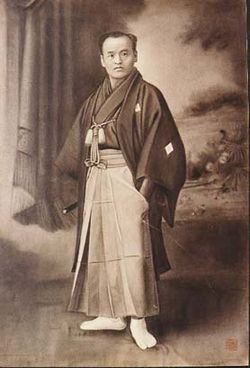I had the opportunity to sit with Kyoshi Jason Carter, the founder of Nyingbulam during the long weekend in August, 2018. As I sat with Sensei, our discussions started off with web-site marketing and the very blog you’re ready now, to discussions about Nyingbulam and what sets it apart from many styles of Jujitsu today.
Then our conversation went to the lineage of Nyingbulam and the many Masters that had a place in the development of the style of jujitsu we study today. I just realized something, as we sat that day enjoying our conversation over a cold beer, the discussion we had spand a history of over 160 years and it was at that point we felt it would be a very unique thing to open up a series of articles on Nyingbulam and the many souls that have had an impact on the development of “The Art of The Modern Samurai”
So I open this series on a Samurai named Takea Sokaku
Takeda Sokaku was born in Aizu region of Japan, in the area of Fukushima. Sōkaku grew up in the time of the Boshin War. Takeda Sokaku was the second son of a samurai Takeda Sōkichi, a samurai of the Takeda Clan who worked his farm and taught at a local school in a Buddhist temple. His mother, Tomi Kurokochi was the daughter of Dengoro Kurokochi, a master of the Yari (Spear) and the Kenjutsu (Sword).
It is believed that Sōkaku received his first Jujitsu training from his father. Sōkichi, Takeda’s father was also a master of the spear and sword and had also once been a Sumo Wrestler. Takeda studied in the school of Hōzōin-ryū founded in the year 1521 where began the study of Jujitsu and in the school of Ono-ha Itto-ryu where he learned to master the swords.
Sōkaku left his region for a period of training, he travelled and fought and trained at many schools under many teachers, Sōkaku spent some time as a live-in student of Kenkichi Sakakibara, headmaster of the Jikishinkage-ryu and was considered to be one of the most famous and skilled swordsmen of the era. Sokaku engaged in many duels with live blades and became known as a great swordsman at a time in history when these things started to become forgotten.
In about 1875, rumor reached Sōkaku that Saigo Takmori had launched his rebellion in Satsuma against the forces of the new Meiji government. He decided immediately that he would go to lend his support. He made it as far as Kyushu but was unable to reach his destination, so he returned to Osaka where he spent the next ten years as a guest in the Kyōshin Meichi-ryū dojo of swordsman Momonoi Shunzo.
Sōkaku lived a somewhat itinerant life, travelling the length and breadth of the country giving seminars in martial arts to military officers, police officers and martial arts enthusiasts, often of high social standing.
Sōkaku’s far-reaching influence
His most famous student was the founder of Aikido, Morihei Ueshiba and it is the popularity of this modern martial arts form that is responsible for much of the interest in Daitō-ryū (Aikido) today
Hosaku Matsuda was taught by Sōkaku, who in turn taught Yoshiji Okuyama, who in turn founded the Hakko-ryu Jujutsu school.
The influence of the teachings of Sokaku Takeda are seen in the techniques used in Aikido today and also in Goshin Jutsu a self defense style of Jujitsu which branches today to Nyingbulam “The Art of the Modern Samurai”

